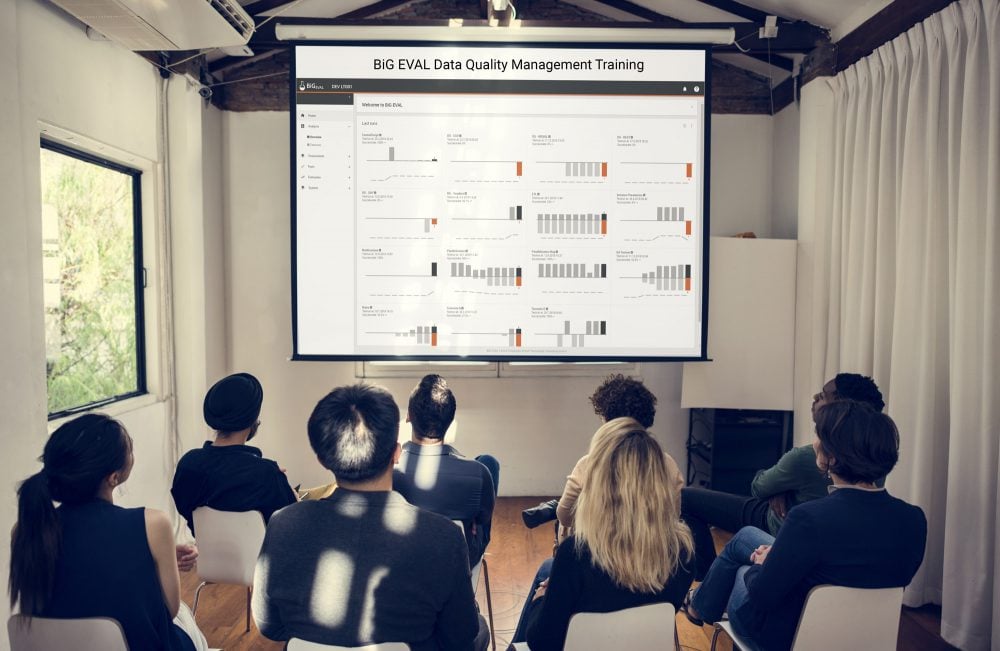Actions to take for successful Data Governance Implementation
This article will help small scale to large scale companies to develop effective data governance programs. The latest buzz words such as Data Analytics, Big Data, Data Visualization, and Data Science may sound intimidating, but at the root they are all data governance elements. The data governance framework works as the backbone which makes sure that there is consistent, visible, and authoritative data. Don`t forget your Data Quality Management, because it has never been as important as it is now!
Data is authoritative as it is the main entity which lets companies and officials gain insights and useful reports to achieve their mission and goals.
To put this into action, the data governance model requires a few elements to be in place. Surprisingly enough, these elements are present in all organizations, they just need to be identified as the correct elements for the correct usage. BiG EVAL will help you in the formalization of these elements into practical and executable steps as we present to you an idea of a 7-Step data governance model that you can design according to your firm and gain all the advantages that effective data governance can give to your company.
Scope and Strategy
Forming Governance Groups
Next, for a successful Data Governance Implementation you need to designate a group of people that will define new roles that will play a vital role in data governance, not just for IT and data specialists, but to engage the whole organization in the data governance process. These are called Governance Groups and are needed to be defined to distribute responsibilities.
Rather than developing new groups, pre-existing officers can perform this task as well. Project Managers, Team Leads, Scrum Masters all can perform the data governor duties. Incorporating data governance into existing structures becomes possible by adopting this approach.
If you need to create new governance groups, determine the best model for your organization through meetings and revisions. Create a sense of responsibility with liaison within the organization, hire a few data governance experts and decentralize responsibilities and distribute them across the hierarchy.
Lack of ownership and leadership will be your most challenging issue during the early stages.
A data governance committee makes high-level decisions that will be reflected thought out the organization. Leaders decide strategic, tactical ad operational measures needed to implement the data governance model practically.
Policies and Rules
Organizations need to follow a set of principles. Implementing a data governance program should not ideally transform the whole culture, policies, and rules of the organization. It should rather be built around them to best suit the employees. Make standard operating procedures and inculcate the habitual transformation of the workers. As a best-practice, incorporate the following rules in the pre-existing rules:
Organizations often have policies for data operations, securities, and decision rights but they may lack coherence and may be outdated. Your leadership and steering committee will have to work, to make policies that balance the need for privacy and security but also presents the data well for all sorts of analysis.
Processes and Procedures
Turning policies and rules into processes and procedures is an essential step. This step is often overlooked and leads to the unpleasant implementation of the policies. This step makes sure all recognized steps are incorporated into practical steps and results are achieved. Sharing insights with governors and stakeholders is much easier if these practices are in action and are part of daily work procedures. Making insights public to stakeholders improves the authenticity and work of the organization as well.
Tools and Systems
Let`s look at the next Step of an effective and successful implementation of data governance.
Finding automated tools and systems that support your processes will lessen the complexity of the task in your organizational leaders’ hands and make the processes more viable. Data Lifecycle can be complemented using correct tools and systems such as data models, visibility methods, metadata glossaries, workflows, data analytics, and diagrams.
You will be shocked to know how just the simple Microsoft Excel can improve the deliverables of data analysts as it helps in making viable observations such as benchmarks and business rules.
Other tools such as Tableau, PowerBI, Python Libraries, and other in-house developed tools are going to transform your company’s data governance and make it your strength. Companies such as Google and Microsoft are data-driven companies too.
Training and Engagement
Everyone at the organization needs to know why data governance-related policies, procedures, and tools exist. This is the root of a healthy data-driven culture. Communicating the data-driven nature of the business to all the employees is going to incorporate data-driven culture throughout the organization other than IT and Data teams. Several layers of trainings can be arranged for employees with different roles, to promote this as a long-lasting habit.
Training specific to data governance groups can be conducted to cover the following:
- Data Governance Tours.
- Committee Meetings.
- Identification of workforce skills and abilities individual wise.
Additionally, trainings for data consumers and producers may be conducted which include rules for creating, sharing, and management of the data.
It is very easy to automatically test your data

Check out the BiG EVAL Academy and learn and gain knowledge about efficient Data Quality Management and Data Test Automation.
Audits and Metrics
You need to put in place audits and metrics to monitor, evaluate, and transform your data governance program and establish a successful data-driven model.
- Compliance Audits: Are people following the policies and procedures that were developed by the governors?
- Security assessments: Do people have correct access and rights only?
- Data Quality Audits: Is the data complete and accurate?
If you establish these audits and metrics, you will know where there are gaps, and what can be done to overcome those gaps? Additionally, if your firm will fairly and efficiently use data accurate numbers will be shown to the stakeholders and may result in more business and customer satisfaction.
As you can see, there are a few points to consider in order to run a successful data governance implementation project.
All things considered, following BiG EVAL’s suggested 7-Step data governance model, will help you get started with your firm’s successful Data Governance Implementation in the right direction. Also, BiG EVAL provides validated data that you can utilize to obtain a highly efficient data-driven governance model.
Implement your project with the right Strategy and Tools to deliver trusted Data - Exactly and in time!
Then :

FREE Exclusive DQA Club
Discover the Secrets of Data Quality Automation
Get to learn every secret of Data Testing and Data Quality Management directly from our experts and partners that are working in the field.
Apply to be a member of our DQA club today and join the circle of competent specialists.
This FREE and exclusive offer ends in:





These are really the important points in a data governance project. Want to learn more about that.
Dear Brian. Keep on following our blog. There will be more about data governance implementation soon.